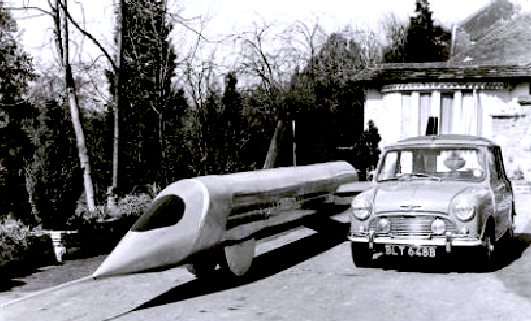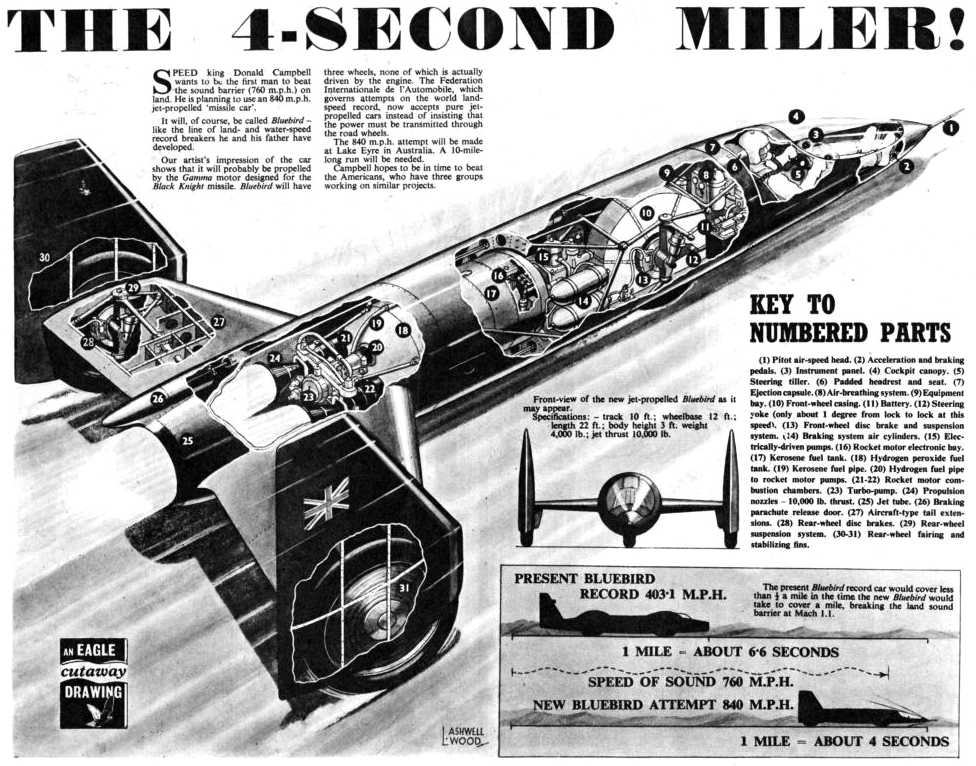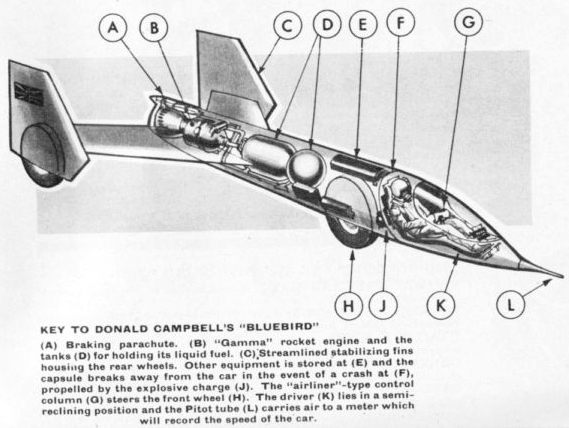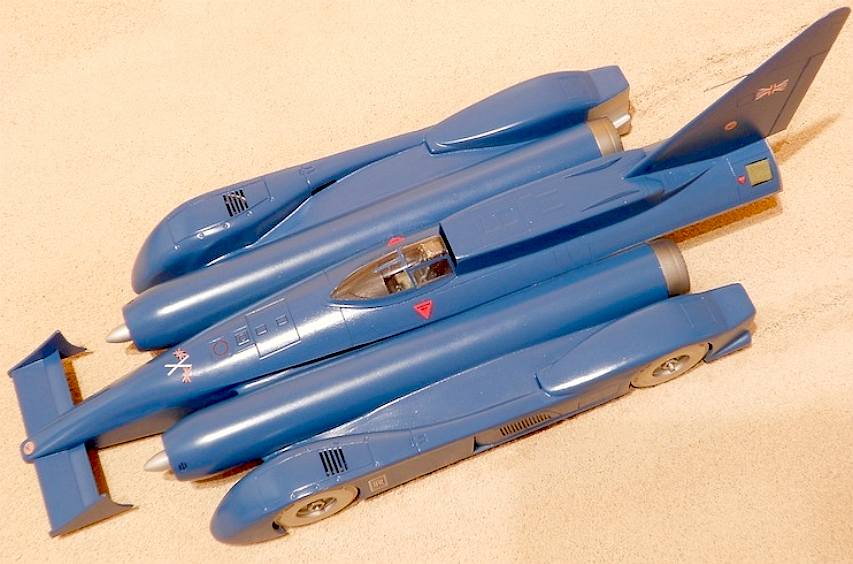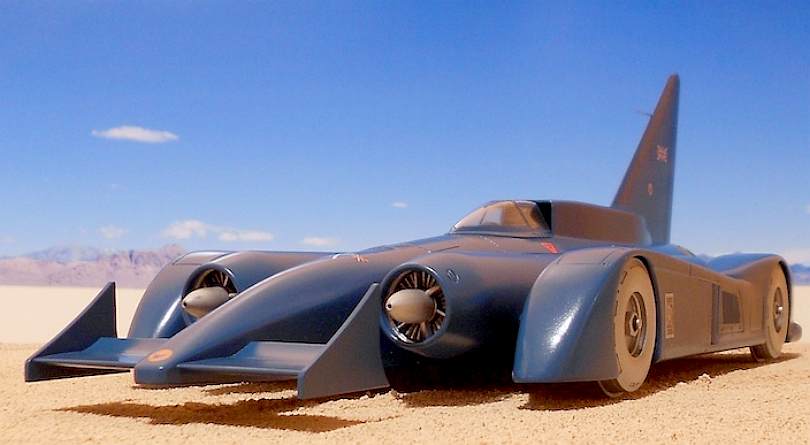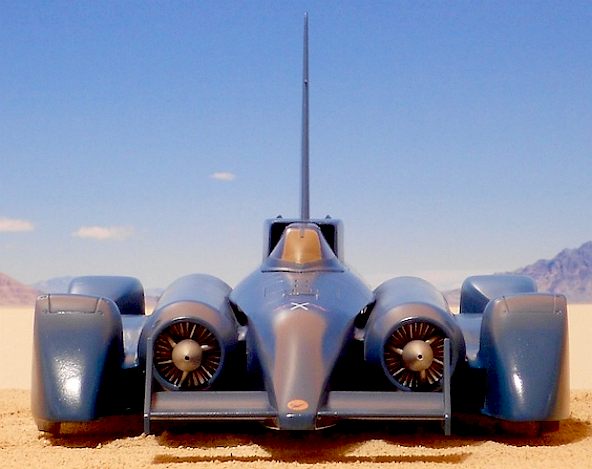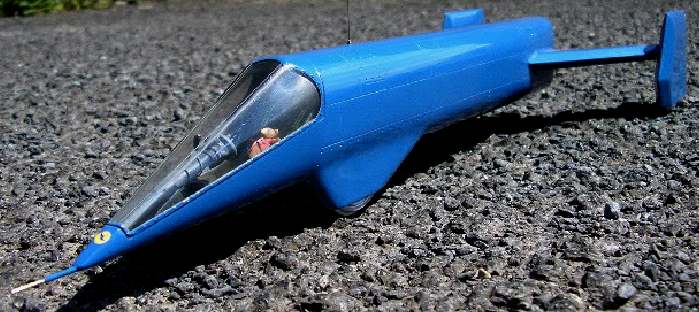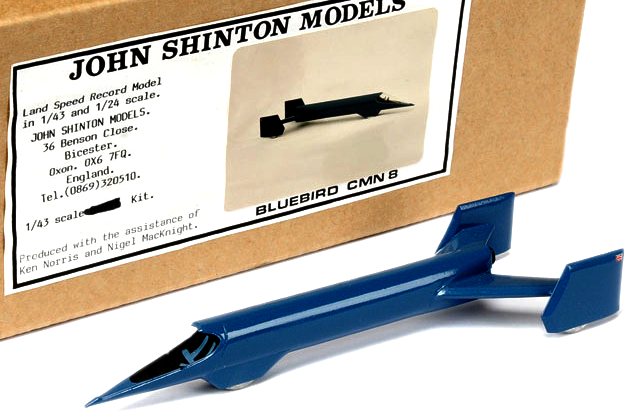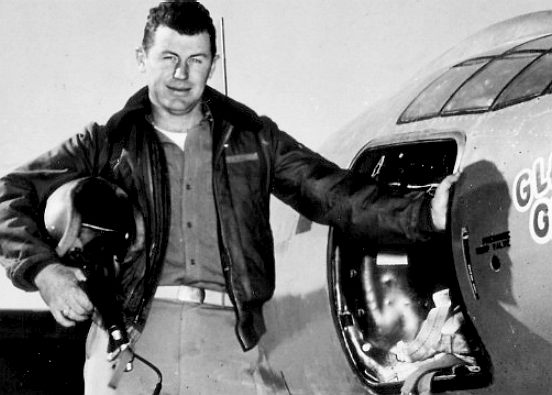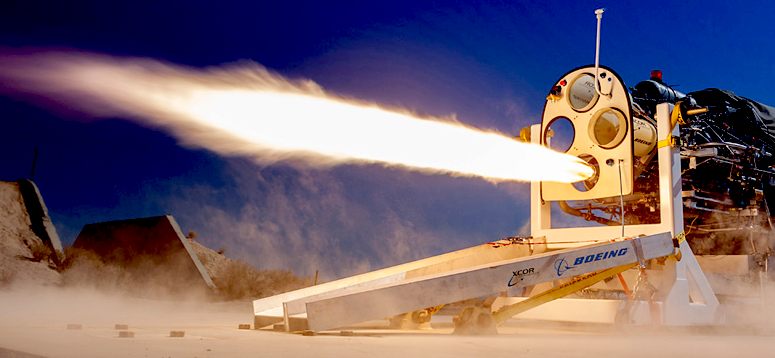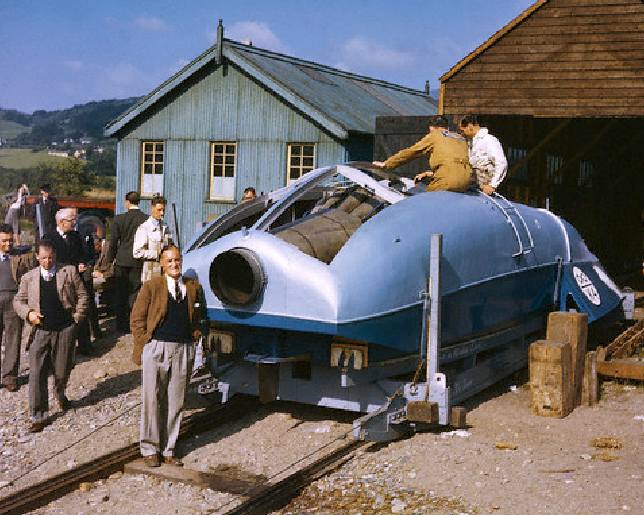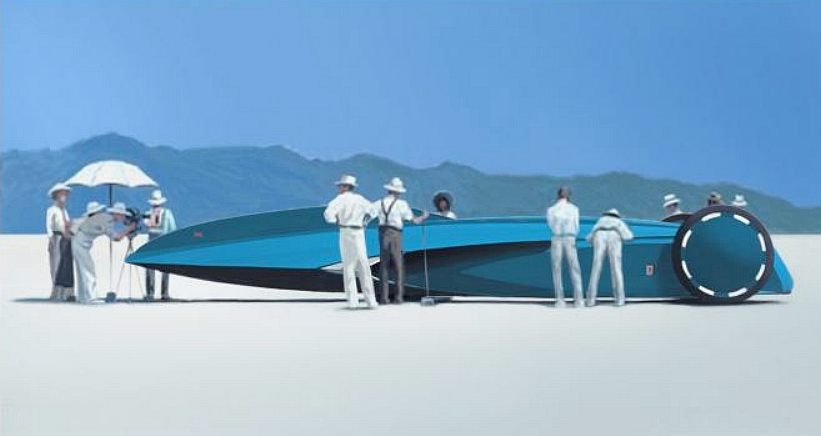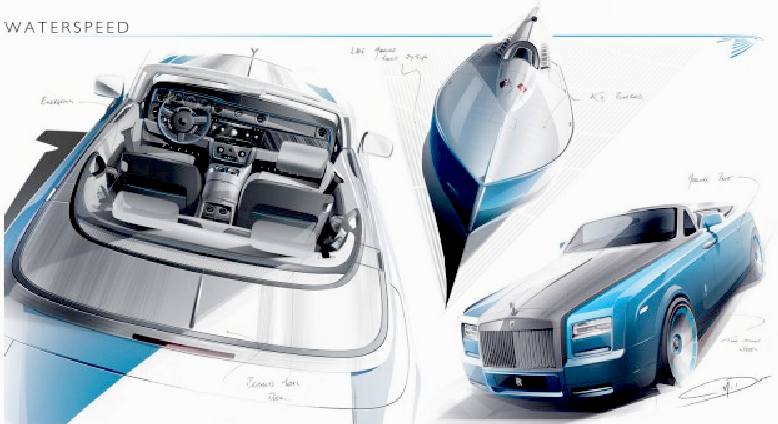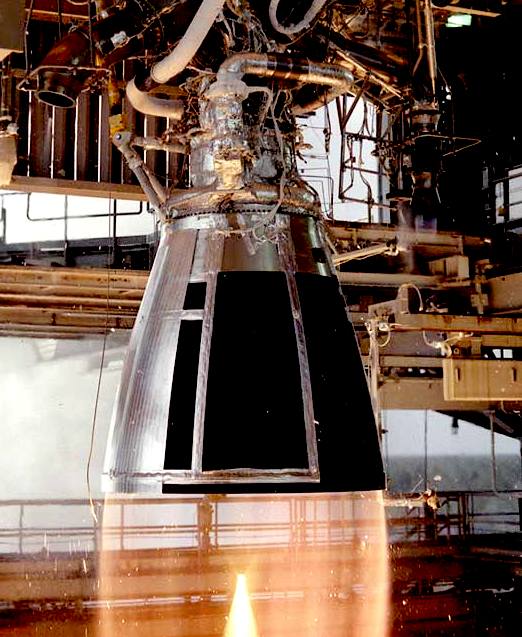|
BLUEBIRD CMN-8 ROCKET CAR - MACH 1.1
|
|||||||||||||||||||||||||||||||
|
DONALD
CAMPBELL
A full size mock-up of the CMN8, alongside a mini. Rockets are woefully inefficient as a means of transport. The only practical use is for space travel, especially launching ships into space and maneuvering satellites with small rocker motors called thrusters.
THE ROCKET CAR
The
Bluebird Mach 1.1 or CMN-8 was a design for a rocket-powered supersonic land speed record car, planned by Donald Campbell but thwarted by his subsequent
death during a
water speed record attempt in Bluebird K7 in early 1967.
Various dimensions were considered and eventually a full-scale mock-up of the car was built measuring 27 ft 8 in (843 cm) long, 8 ft 6 in (259 cm) wide at the rear wheels, with an overall height of just 3 ft 7 in (109 cm). Ground clearance was projected to be only 4.5 in (11 cm), giving Bluebird Mach 1.1 a very low centre of gravity and roll centre. The predicted weight was 1,600 kg (3,500 lb) including propellants. Bluebird Mach 1.1 would thus have a power-to-weight ratio of 22,000 bhp (16,000 kW; 22,000 PS) per tonne.
After Campbell's death, the project continued at a low key for some years, still involving
Leo Villa, with Norris as Design Consultant from 1968-1971. In 1973,
Nigel McKnight became involved, but failed to raise the necessary sponsorship.
A nicely detailed "what if" model of a twin turbojet engined supersonic Bluebird - very Thrust SSC like in appearance and convincing.
SPECIFICATIONS
This is a model of the rocket powered CMN8 Bluebird that was never to be, but was very much on the cards. The CMN8 was a very clean design that shares rear wheel features with other vehicles. The land missile was mocked up full size and kept on Donald's drive for a while. Who knows, one day there may be a JW9 rocket/jet powered car - perhaps after a few more haggis and the sound of the bagpipes to a full moonlit night.
All current spacecraft use chemical rockets (bipropellant or solid-fuel) for launch, though some (such as the Pegasus rocket and SpaceShipOne) have used air-breathing engines on their first stage. Most satellites have simple reliable chemical thrusters (often monopropellant rockets) or resistojet rockets for orbital station-keeping and some use momentum wheels for attitude control. Soviet bloc satellites have used electric propulsion for decades, and newer Western geo-orbiting spacecraft are starting to use them for north-south
station-keeping and orbit raising. Interplanetary vehicles mostly use chemical rockets as well, although a few have used ion thrusters and Hall effect thrusters (two different types of electric propulsion) to great success.
LEFT - Chuck Yaeger, the original jet powered, sound barrier record breaker. RIGHT - The Bell X-1, designated originally as XS-1, was a joint National Advisory Committee for Aeronautics-U.S. Army Air Forces-U.S. Air Force supersonic research project built by the Bell Aircraft Company. Conceived during 1944 and designed and built during 1945, it achieved a speed of nearly 1,000 miles per hour (1,600 km/h; 870 kn) during 1948. A derivative of this same design, the Bell X-1A, having greater fuel capacity and hence longer rocket burning time, exceeded 1,600 miles per hour (2,600 km/h; 1,400 kn) during 1954. The X-1 was the first manned airplane to exceed the speed of sound in level flight and was the first of the so-called X-planes, a series of American experimental rocket planes designated for testing of new technologies and often kept secret.
XCOR develops rocket-propelled vehicles, rocket propulsion systems, and propulsion components to customer order. XCOR is a leader in the development of dependable, low-cost rocket engines. They have developed a series of proprietary engines and igniters, and have built, tested, and flown the EZ-Rocket twenty-six times and the X-Racer 40 times. They have many rocket motor designs from 15 lb thrust up to 7,500 lbf. XCOR’s engines burn a variety of non-toxic fuels, including kerosene, hydrogen, methane, ethane, propane, alcohol and kerosene using oxidizers such as liquid oxygen and nitrous oxide. The above picture is a test firing on a rocket motor in the Mojave desert region of California.
ROCKET SAFETY
A very rare picture of the 'Slipper', as the K4 jet boat came to be known. It was also a bit of a damp squib in water speed record terms, but set the precedent for father and son in moving to thrust for propulsion. No doubt the exploits of Chuck Yaeger also played a part in firing up the imagination of a young Donald Campbell.
MALCOLM CAMPBELL HERITAGE TRUST
The Malcolm Campbell Heritage Trust (MCHT) is, according to Donald Wales, a body set up by family members in the 2000s to seek to preserve what they may of Sir Malcolm. Despite the name, we are presuming that this extends to Donald Campbell's projects. For that reason we wonder if the surviving relatives of MC and DC, to include Joseph and Charlotte Wales, might be considering re-awakening the CN8 project to compete against Richard Noble's Bloodhound project.
The activities of the MCHT is not known or published. We do not know if there is a collection or museum that is operated by this trust, what they own and don't own. If you have any information of projects past or planned please let us know.
Vettriano style artwork depicting a future Blue Bird at Bonneville
LINKS
http://en.wikipedia.org/wiki/Bluebird_Mach_1.1 The unobtainable campbell book preview Autosport Forums specifications-for-donald-campbells-proposed-bluebird-cn8-rocket-car http://en.wikipedia.org/wiki/Bell_X-1 http://en.wikipedia.org/wiki/Rocket_engine http://forums.autosport.com/topic/64805-specifications-for-donald-campbells-proposed-bluebird-cn8-rocket-car/ https://www.facebook.com/BluebirdSupportersClub http://ginacampbellqso.com/record-attempts/great-britain/ https://www.bonhams.com/auctions/14259/lot/497/ http://www.bluebirdspeedrecords.com/timeline.php http://en.wikipedia.org/wiki/Water_speed_record http://www.touchwoodmodels.com/water-speed-record-models/mach-one-models.html http://www.historicracer.com/motorsport/the-unobtainable-campbell-book-preview/ http://www.sirmalcolmcampbell.com/sirwater.html http://en.wikipedia.org/wiki/Blue_Bird_K4 http://www.bonhams.com/auctions/14259/lot/496/ http://www.bonhams.com/auctions/18213/lot/238/ Arthur Benjamins - http://www.bluebirdpublications.co.uk/
Rolls Royce Phantom "Waterspeed" commemorative edition drophead coupe. This special limited run of custom cars is dedicated to Sir Malcolm Campbell and the famous K3, where the K4 and K7 would not be appropriate. The Rolls-Royce Phantom Drophead Coupé Waterspeed Collection was previewed to selected UK press and customers at an exclusive event on the site of the original Bluebird Motor Company – now the Bluebird Restaurant – on the King’s Road, London on Tuesday 13 May 2014. We can't wait to see if RR might come up with a custom Phantom as a tribute to DC and his rocket car.
SIR MALCOLM CAMPBELL'S BLUE BIRDS
NASA - testing a rocket motor. Imagine a couple of these strapped to an aerodynamic truck chassis with air control surfaces to prevent lift off.
DONALD CAMPBELL'S BLUEBIRDS (production speed boat)
|
|||||||||||||||||||||||||||||||
|
This
website is Copyright © 2014 Bluebird Marine Systems Limited.
The names Bluebird, Bluefish, Solar Navigator™, and the blue bird in flight
|
|||||||||||||||||||||||||||||||
